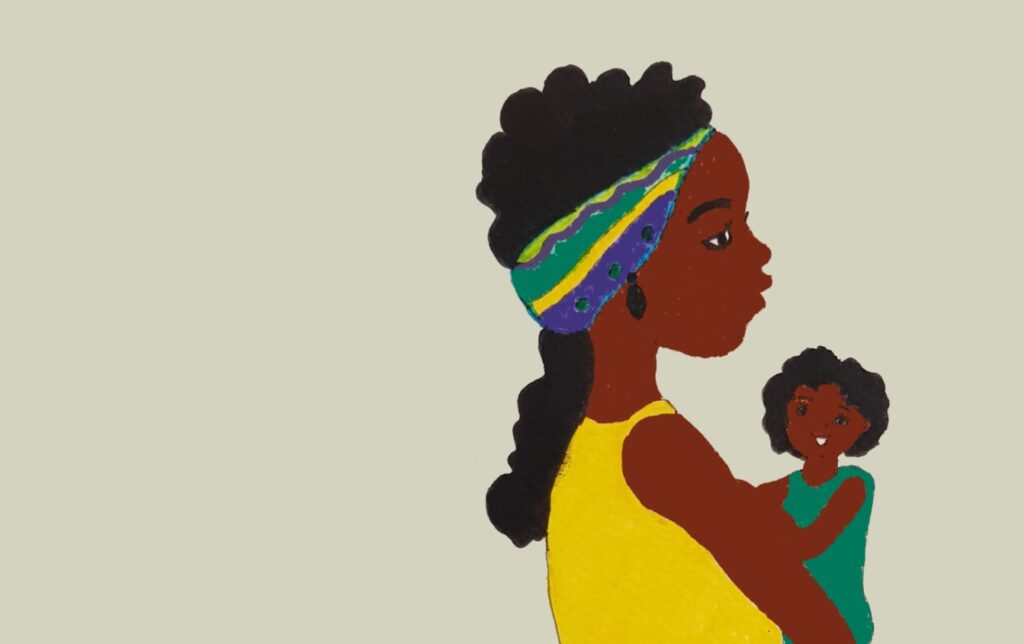by Irene Caselli

I recently took my son on a trip to a small village in Ghana, near the city of Kumasi. There we met Adjoa, a young girl who told us the story of her older sister: a wooden doll named Akua’ba that her mother carried on her back before Adjoa was born.
We then travelled all the way to New York City and met Julián and his grandmother on the subway. We followed them down the street, all the way back to Nana’s apartment, where Julián transformed himself into a mermaid.
Later we had the chance to visit Yazan’s house in Damascus. It was a dangerous time and the young boy could not leave his house and play with his friends anymore. His school was closed and his parents were constantly watching the news on television.
To confirm, these weren’t actual physical trips. In these times of lockdowns and confined environments, moving anywhere further than our neighbourhood has become difficult to implement, and even imagine. I’ve personally dreamt about travelling to places where I’ve lived before, and to countries I haven’t even seen a picture of. But there’s an even easier way to move around the world, easier than relying on your dreams. And it’s a way that you can bring your child along too, no matter your personal circumstances or the pandemic levels. Yes, I’m talking about reading.
When it comes to children’s literature, there’s a huge potential to the movement that books can generate. This has to do with the possibility to see other places and people via picture books, but also with a more internal, subconscious movement. Research shows that picture books play a great role in shaping who we are, how we come to see ourselves, and who we will become.
Paraphrasing the words of US educator Rudine Sims Bishop, who did pioneering work on the importance of multicultural children’s literature, books can be windows into the world, but also mirrors that reflect human experience back to us. Or as Adrienne Yabouza, an author from the Central African Republic, told me in an email: “I believe children all over the world are entitled to stories from all over the world. Reading is a way of getting closer to others, of understanding them and of loving them.”
Books are especially important in the first years of life, when we create the foundations for our worldview and attitudes towards the external world. “By three months, infants with extensive exposure to same-race faces prefer those faces. The pervasiveness of different forms of prejudice in children under the age of ten years has been well established,” said Dr Krista Aronson, a psychology professor and director of Diverse BookFinder, a collection of children’s picture books featuring Black and Indigenous people and People of Colour. She explained that there’s clear evidence in children of favouritism for those who look like them in areas such as ethnicity, race, body size, nationality and language.
It’s perhaps not surprising then that children retain plot better when they read books with characters that look like them. But they also favour realistic and factual stories, and it’s by exposing children to more diversity through books that they can experience worlds that are different to theirs, fostering curiosity, understanding and developing empathy, says Aronson. In this sense, she adds, multicultural picture books can create a starting point to end racism, ableism and sexism and make so that today’s children become more empowered and empathetic.
But the current state of the industry is far from diverse, especially in English- speaking countries. Data collected by the Cooperative Children’s Book Center in the US shows that in 2019 83.2% of children’s books published in the country were written by white people, with only 5.7% authored by Black writers and 6.1% by Latinx writers. When it comes to main characters featured in the books, the diversity is also very low: 11.9% are Black, 8.7% are Asian, 9.2% have Brown skin, 41.8% are white, and 29.2% are animals or others. Other indexes also show a lack of diversity among industry staff, with 81% of people in publishing identifying as straight and 89% as able-bodied.
“End of racism starts on the bookshelf,” says Nadine Kaadan, a Syrian book author who was named on the BBC 100 Women in 2020 for her influential work.
To find out what can be done about it, read the full story here: https://www.rights-studio-magazine.org/when-stories-take-us-places
Irene Caselli is a multimedia reporter and writer, with over 15 years of experience in radio, TV and print, now focusing on early childhood, reproductive rights, and carers. She is also a senior advisor for The Early Childhood Reporting Initiative at the Dart Center.
For a decade, Caselli was a foreign correspondent in Latin America, reporting for the BBC, The Washington Post, The Guardian, The New York Times and others. In 2019, she started covering early childhood for The Correspondent. In January 2021, she launched her own newsletter, The First 1,000 Days, funded by readers, where she continues her writing about the first 1,000 days, the foundational period of our lives that is too often overlooked.
Caselli published a chapter in “Unbias the News,” a book about how to make journalism more diverse. She produced a documentary on women’s football and gender inequality, and one of her short films on the same subject received a prize for collaborative journalism.
Caselli has been awarded fellowships by the International Women’s Media Foundation, the European Journalism Centre and the Solutions Journalism Network. She speaks six languages (English, Italian, Spanish, German, French, Portuguese), and is now learning Greek. In her free time, she tries to keep up with her son Lorenzo.
Illustrations by Lutay B. Chitiya
